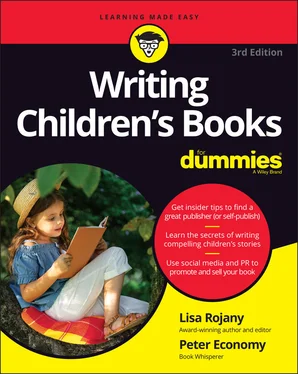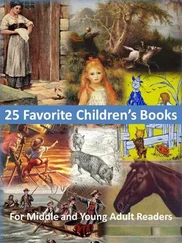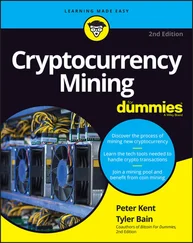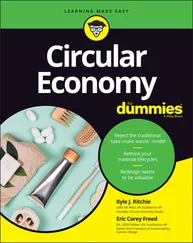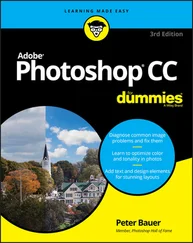Peter Economy - Writing Children's Books For Dummies
Здесь есть возможность читать онлайн «Peter Economy - Writing Children's Books For Dummies» — ознакомительный отрывок электронной книги совершенно бесплатно, а после прочтения отрывка купить полную версию. В некоторых случаях можно слушать аудио, скачать через торрент в формате fb2 и присутствует краткое содержание. Жанр: unrecognised, на английском языке. Описание произведения, (предисловие) а так же отзывы посетителей доступны на портале библиотеки ЛибКат.
- Название:Writing Children's Books For Dummies
- Автор:
- Жанр:
- Год:неизвестен
- ISBN:нет данных
- Рейтинг книги:4 / 5. Голосов: 1
-
Избранное:Добавить в избранное
- Отзывы:
-
Ваша оценка:
- 80
- 1
- 2
- 3
- 4
- 5
Writing Children's Books For Dummies: краткое содержание, описание и аннотация
Предлагаем к чтению аннотацию, описание, краткое содержание или предисловие (зависит от того, что написал сам автор книги «Writing Children's Books For Dummies»). Если вы не нашли необходимую информацию о книге — напишите в комментариях, мы постараемся отыскать её.
Writing Children’s Books For Dummies,
For Dummies
Writing Children’s Books For Dummies
Writing Children's Books For Dummies — читать онлайн ознакомительный отрывок
Ниже представлен текст книги, разбитый по страницам. Система сохранения места последней прочитанной страницы, позволяет с удобством читать онлайн бесплатно книгу «Writing Children's Books For Dummies», без необходимости каждый раз заново искать на чём Вы остановились. Поставьте закладку, и сможете в любой момент перейти на страницу, на которой закончили чтение.
Интервал:
Закладка:
A novelty book goes beyond just words and pictures on flat pages. It’s often three-dimensional and always interactive (meaning the child must engage more than just their eyes in the experience). From pop-ups to pull-tabs, from juggling balls to paper dolls, innovative novelty books can really engage the imagination (see Figure 2-7 for an example). When any type of children’s book has something in addition to just flat paper and images, it moves into the novelty category.
 Printing just words and illustrations on paper has become expensive — especially if the publisher prints only a few thousand copies to start. And novelty books always go beyond simply printed and bound paper.
Printing just words and illustrations on paper has become expensive — especially if the publisher prints only a few thousand copies to start. And novelty books always go beyond simply printed and bound paper.
Once upon a time, publishers could afford to print tens of thousands of copies of a novelty title right off the bat. But when the market became saturated, it couldn’t sustain all those titles. So the publishers could no longer count on economies of scale to offset the extra costs of hand-assembly or packaging the items that came with the book.
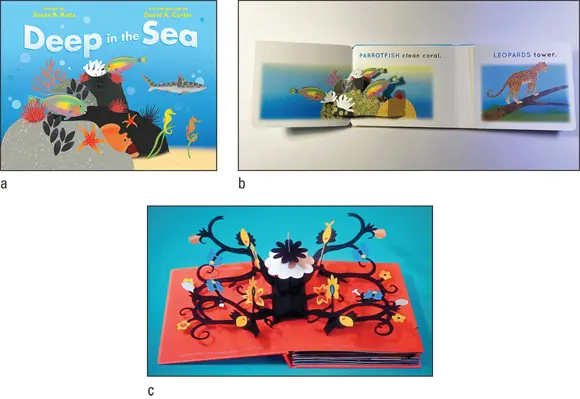
a) cover and b) interior from Deep in the Sea by Susan B. Katz with illustrations by David A. Carter. Text copyright © 2021 by Susan B. Katz. Illustrations copyright © 2021 David A. Carter. Reprinted with the permission of Little Simon, an imprint of Simon & Schuster Children’s Publishing Division. All rights reserved. c) interior from Hide and Seek, reprinted courtesy of the author/illustrator David A. Carter.
FIGURE 2-7:Example novelty books.
For these reasons, you find very few players in the novelty book market today. What does that mean for you? Unless you’re David A. Carter (a novelty book creator who can write, illustrate, design, and engineer his own titles), Robert Sabuda (another Renaissance publishing star of multiple talents in the pop-up world), or an expert in some form of artistry such as paper artist Hélène Druvert, your chances of getting a novelty book to market are slim to none — unless you self-publish. (We fill you in on the world of self-publishing in Chapter 19.)
Graphic novels
Graphic novels are books that have a lot of pictures and fewer words, but are aimed at older readers: namely, middle-graders (ages 7 to 10), tweens (ages 9 to 12), young adult readers (12 and up), and even adults (see Figure 2-8). Not surprisingly, every page of a graphic novel boasts graphics, which can come in the form of black-and-white illustrations, color illustrations, comics, or captured video/TV/movie photos. Most often, the illustrations look more comic-book-like than full-page picture book illustrations.
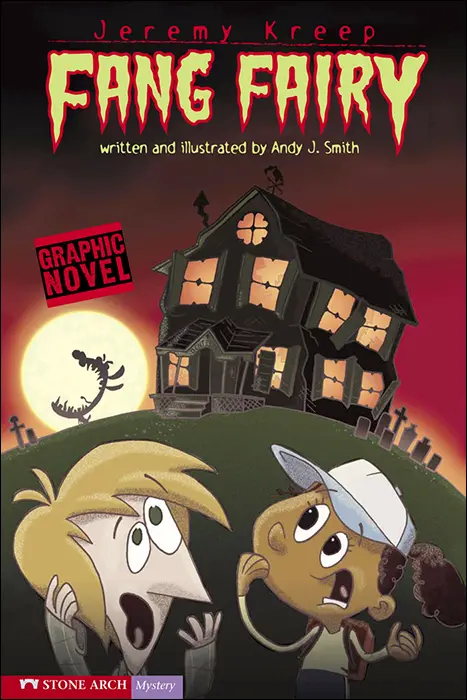
From Jeremy Kreep: Fang Fairy reprinted courtesy of Stone Arch Books. © 2007 by Andy J. Smith.
FIGURE 2-8: Jeremy Kreep: Fang Fairy, a graphic novel .
Graphic novels are, strictly speaking, novels in comic form. But they have evolved way beyond comic books. These novel-length stories feature
A plethora of illustrations: Including styles such as fine art, cartoon-like, pencil and ink, and more.
Cover all sorts of topics: From history, to memoir, to fiction, to biography, to nonfiction and anthologized works.
Relatively few words: Graphic novels have plenty of words, but nothing near the word count of a novel that doesn’t have pictures.
Aspects of style: Bold, italic, underline, a lot of exclamation points, and a ton of question marks often dramatize the text. You often see word balloons and sound effects.
Graphic novels are often digest sized (5½ inches wide x 8½ inches high — about the size of a piece of paper folded in half. In the past, becoming a graphic novel writer generally required the ability to illustrate in the style of graphic novels or comics; but today, many graphic novels originate with the story and text, and the publisher hires the artist separately. If you’re a graphic novel author, you can also independently pair up with someone who has the artistic talent you’re looking for. (For information on illustrating your work, see Chapter 15.)
Manga is a heavily illustrated format similar to graphic novels. In fact, manga often overlaps with graphic novels. But many manga are comic books — some shorter, like traditional comic books, some longer, more like graphic novels. We talk more about manga and anime in Chapter 3, when we discuss genres.
PICKING THE BRAIN OF A CHILDREN’S BOOK EDITOR
Erin E. Molta is an editor who has worked across a broad spectrum of formats in children’s publishing: from novelty books, to licensed books, to book clubs, to young adult novels — even running her own editorial service. If novelty books are your passion, she has some tips about what she looks for in novelty book submissions:
What formats sell: “It’s not so much the format but the author. Straight board books by Sandra Boynton sell continually, lift-the-flap board books by Karen Katz, as do classic board books reprinted from best-selling picture books, such as Eric Carle’s Papa, Please Get the Moon for Me (Little Simon).”
The best formats for new writers: “Again, the manuscript dictates a format, though we have certain formats that we consistently publish — mostly holiday or seasonal titles, like Sparkle N Twinkle or Sparkle N Shimmer series. They are holiday-based and have glitter and/or sequins on each spread.”
What formats constantly need new ideas: “The buzzwords these days are new and innovative. Everybody wants something different. So it can’t just be a flap book, it must be a flap book with touch-and-feel, or sound, or pop-ups and foil, glitter, acetate — and it has to be able to be produced really inexpensively, too!”
The most common pitfalls for new writers and in what formats: “Everybody thinks they can write for children. It’s easy, right? But most people are writing as an adult to a child rather than for — or with — a child. Kids want the text to be on their level. It doesn’t mean it has to be childish — just child-appealing and childlike.”
What grabs your attention: “New and innovative! The key to a successful format for the youngest reader is how it is integral to the text and art. If you have flaps in a book but there’s no incentive to lift them — and once you do, you don’t care — then that is a bad use of the flap as a technique to further the story and enhance the reading experience. I’m looking for truly interactive books, where a child can spin a wheel to find an answer or press a button, or something pops up to stimulate understanding.“I’m looking for the perfect integration of an interactive element and lively text. Say you have animals and it’s counting — and the animals are night creatures, rather than on the farm (I’m sick of farm animal books). Or you’re doing a book on colors, but it’s in outer space. There are zillions of books about colors, shapes, counting, and opposites, but something out of the ordinary sparks my interest!”
What leads to rejection: “Tell me you read it to your students, grandkids, or even your very own children and they loved it. Of course they did! Would any kid say they didn’t? Poor spelling doesn’t help either, nor do farm animals.”
Читать дальшеИнтервал:
Закладка:
Похожие книги на «Writing Children's Books For Dummies»
Представляем Вашему вниманию похожие книги на «Writing Children's Books For Dummies» списком для выбора. Мы отобрали схожую по названию и смыслу литературу в надежде предоставить читателям больше вариантов отыскать новые, интересные, ещё непрочитанные произведения.
Обсуждение, отзывы о книге «Writing Children's Books For Dummies» и просто собственные мнения читателей. Оставьте ваши комментарии, напишите, что Вы думаете о произведении, его смысле или главных героях. Укажите что конкретно понравилось, а что нет, и почему Вы так считаете.
